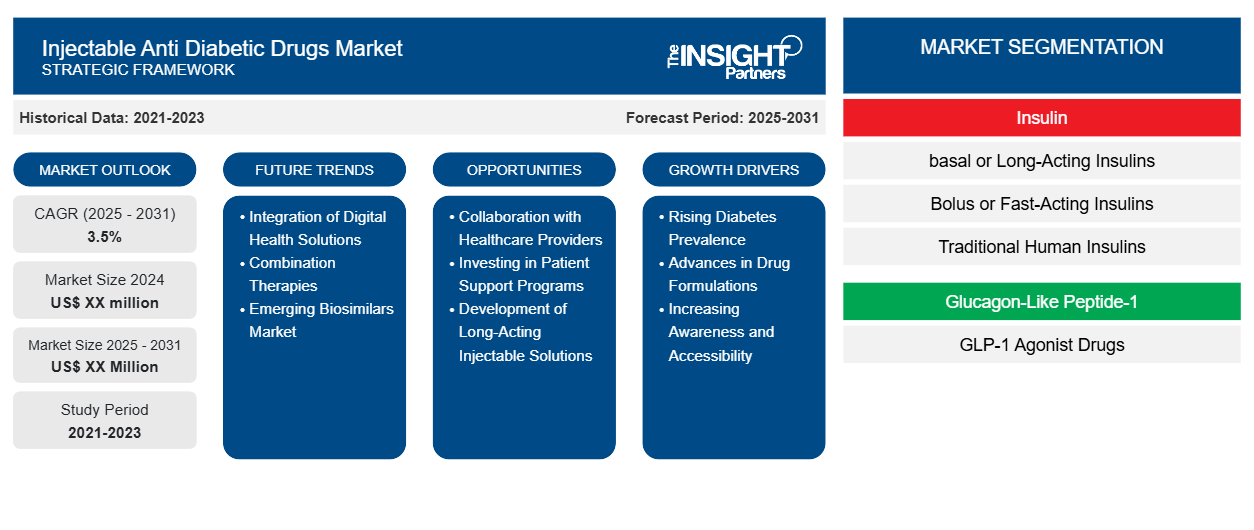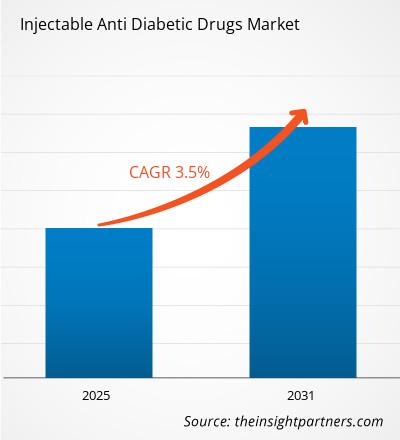The Injectable Anti Diabetic Drugs Market is expected to register a CAGR of 3.5% from 2025 to 2031, with a market size expanding from US$ XX million in 2024 to US$ XX Million by 2031.
The report is segmented by Insulin (basal or Long-Acting Insulins, Bolus or Fast-Acting Insulins, Traditional Human Insulins, Combination Insulins, and Biosimilar Insulins). Futher, it is segmented based on EGlucagon-Like Peptide-1 (GLP-1) Agonist Drugs (dulaglutide, Exenatide, Liraglutide, Lixisenatide, and Semaglutide). The global analysis is further broken-down at regional level and major countries. The report offers the value in USD for the above analysis and segments.
Purpose of the Report
The report Injectable Anti Diabetic Drugs Market by The Insight Partners aims to describe the present landscape and future growth, top driving factors, challenges, and opportunities. This will provide insights to various business stakeholders, such as:
- Technology Providers/Manufacturers: To understand the evolving market dynamics and know the potential growth opportunities, enabling them to make informed strategic decisions.
- Investors: To conduct a comprehensive trend analysis regarding the market growth rate, market financial projections, and opportunities that exist across the value chain.
- Regulatory bodies: To regulate policies and police activities in the market with the aim of minimizing abuse, preserving investor trust and confidence, and upholding the integrity and stability of the market.
Injectable Anti Diabetic Drugs Market Segmentation
Insulin
- basal or Long-Acting Insulins
- Bolus or Fast-Acting Insulins
- Traditional Human Insulins
- Combination Insulins
- Biosimilar Insulins
Glucagon-Like Peptide-1
- GLP-1 Agonist Drugs
You will get customization on any report - free of charge - including parts of this report, or country-level analysis, Excel Data pack, as well as avail great offers and discounts for start-ups & universities
Injectable Anti Diabetic Drugs Market: Strategic Insights

- Get Top Key Market Trends of this report.This FREE sample will include data analysis, ranging from market trends to estimates and forecasts.
Injectable Anti Diabetic Drugs Market Growth Drivers
- Rising Diabetes Prevalence: The increasing number of diabetic patients worldwide is one of the key factors driving the market. Lifestyle changes, poor diet, and genetic predisposition are contributing to a rise in both Type 1 and Type 2 diabetes cases. This growing patient pool demands effective treatment solutions, fostering the market for injectable drugs.
- Advances in Drug Formulations: Continuous research and innovation have led to the development of advanced injectable anti-diabetic drugs with enhanced efficacy, longer durations of action, and fewer side effects. This has increased the adoption of injectable therapies among patients who seek better treatment outcomes, boosting market growth.
- Increasing Awareness and Accessibility: As awareness regarding diabetes management improves, more patients are seeking professional treatment. Healthcare systems in developing countries are also improving, providing better access to injectable therapies. This expanded access helps drive demand for injectable drugs, particularly in under-served regions.
Injectable Anti Diabetic Drugs Market Future Trends
- Integration of Digital Health Solutions: Future injectable drugs may come with integrated digital health technologies, such as apps and smart devices, to help patients monitor their blood sugar levels and manage drug administration more effectively. This trend aims to enhance patient adherence and improve long-term outcomes in diabetes management.
- Combination Therapies: The development of combination injectable therapies is on the rise, with drugs that combine insulin or GLP-1 agonists with other anti-diabetic agents. These formulations are designed to offer convenience, simplify dosing schedules, and enhance therapeutic efficacy, making them attractive to both healthcare providers and patients.
- Emerging Biosimilars Market: The emergence of biosimilars in the injectable anti-diabetic drugs market will likely drive down costs, making treatments more accessible to a broader population. With the expiration of patents for major branded drugs, biosimilars are expected to gain market share and increase competition, leading to price reductions.
Injectable Anti Diabetic Drugs Market Opportunities
- Collaboration with Healthcare Providers: Pharmaceutical companies have the opportunity to partner with healthcare providers to enhance patient education and promote better adherence to injectable therapies. These collaborations can lead to more effective disease management, improving long-term patient outcomes and fostering brand loyalty.
- Investing in Patient Support Programs: Developing patient support programs that focus on training patients for proper injection techniques, offering financial assistance, and providing counseling can drive the adoption of injectable drugs. Companies that invest in these initiatives can foster patient trust and loyalty, improving retention rates.
- Development of Long-Acting Injectable Solutions: The development of long-acting injectable solutions offers significant market potential. Patients often prefer treatments that require fewer injections, and long-acting formulations can improve convenience and adherence, addressing the challenges of daily insulin injections. Companies focusing on this innovation can meet the growing demand for less frequent dosing options.
Injectable Anti Diabetic Drugs Market Regional Insights
The regional trends and factors influencing the Injectable Anti Diabetic Drugs Market throughout the forecast period have been thoroughly explained by the analysts at The Insight Partners. This section also discusses Injectable Anti Diabetic Drugs Market segments and geography across North America, Europe, Asia Pacific, Middle East and Africa, and South and Central America.
Injectable Anti Diabetic Drugs Market Report Scope
| Report Attribute | Details |
|---|---|
| Market size in 2024 | US$ XX million |
| Market Size by 2031 | US$ XX Million |
| Global CAGR (2025 - 2031) | 3.5% |
| Historical Data | 2021-2023 |
| Forecast period | 2025-2031 |
| Segments Covered |
By Insulin
|
| Regions and Countries Covered | North America
|
| Market leaders and key company profiles |
|
Injectable Anti Diabetic Drugs Market Players Density: Understanding Its Impact on Business Dynamics
The Injectable Anti Diabetic Drugs Market is growing rapidly, driven by increasing end-user demand due to factors such as evolving consumer preferences, technological advancements, and greater awareness of the product's benefits. As demand rises, businesses are expanding their offerings, innovating to meet consumer needs, and capitalizing on emerging trends, which further fuels market growth.

- Get the Injectable Anti Diabetic Drugs Market top key players overview
Key Selling Points
- Comprehensive Coverage: The report comprehensively covers the analysis of products, services, types, and end users of the Injectable Anti Diabetic Drugs Market, providing a holistic landscape.
- Expert Analysis: The report is compiled based on the in-depth understanding of industry experts and analysts.
- Up-to-date Information: The report assures business relevance due to its coverage of recent information and data trends.
- Customization Options: This report can be customized to cater to specific client requirements and suit the business strategies aptly.
The research report on the Injectable Anti Diabetic Drugs Market can, therefore, help spearhead the trail of decoding and understanding the industry scenario and growth prospects. Although there can be a few valid concerns, the overall benefits of this report tend to outweigh the disadvantages.
Frequently Asked Questions
Who are the prominent players in injectable anti diabetic drugs market?
Which is the fastest growing region in injectable anti diabetic drugs market?
Which region accounts for highest revenue share in injectable anti diabetic drugs market?
What years does this injectable anti diabetic drugs market cover?
At what CAGR the injectable anti diabetic drugs market is projected to grow?
Which are the major driver boosting the injectable anti diabetic drugs market growth?
1. Rising Diabetes Prevalence.
2. Advances in Drug Formulations.
- Historical Analysis (2 Years), Base Year, Forecast (7 Years) with CAGR
- PEST and SWOT Analysis
- Market Size Value / Volume - Global, Regional, Country
- Industry and Competitive Landscape
- Excel Dataset
Recent Reports
Related Reports
Testimonials
Reason to Buy
- Informed Decision-Making
- Understanding Market Dynamics
- Competitive Analysis
- Identifying Emerging Markets
- Customer Insights
- Market Forecasts
- Risk Mitigation
- Boosting Operational Efficiency
- Strategic Planning
- Investment Justification
- Tracking Industry Innovations
- Aligning with Regulatory Trends





















 Get Free Sample For
Get Free Sample For